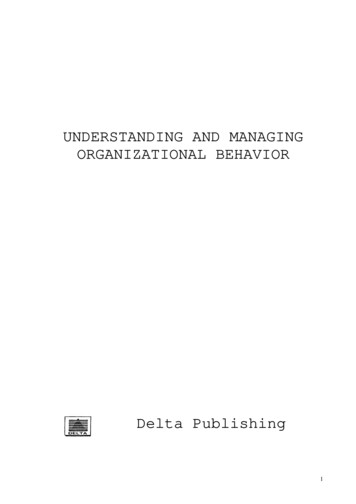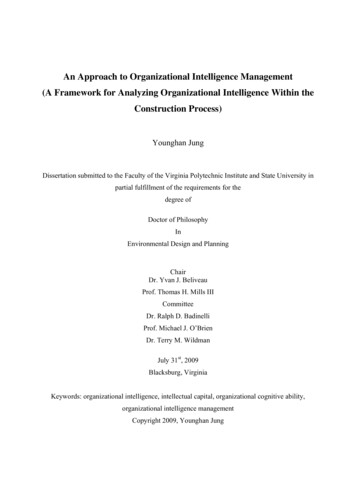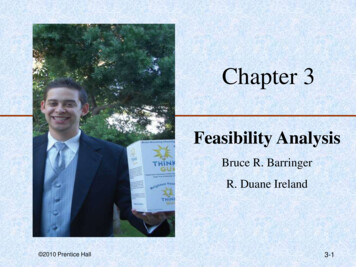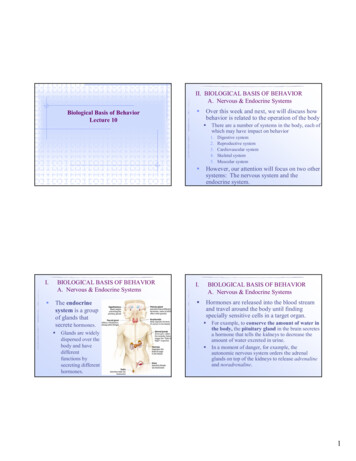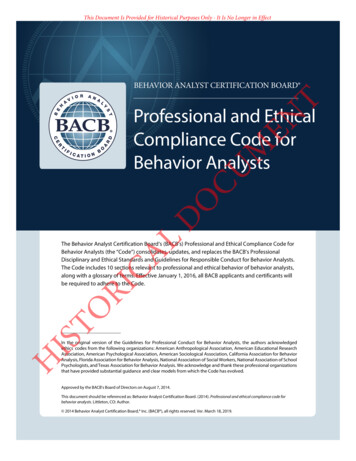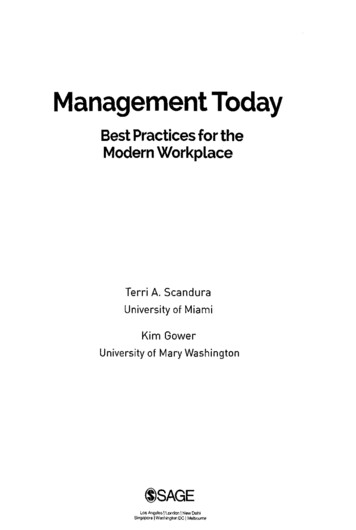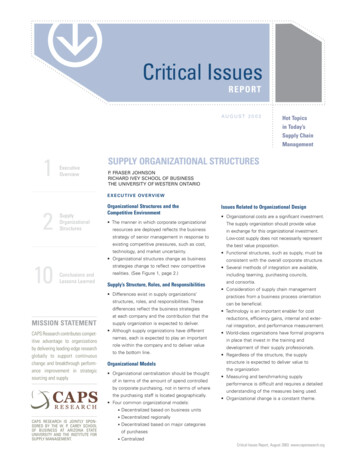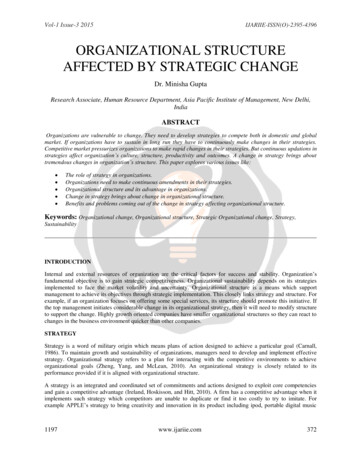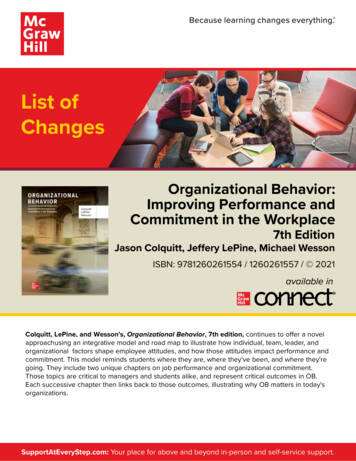
Transcription
Organizational Behavior:Improving Performance andCommitment in the Workplace7th EditionJason Colquitt, Jeffery LePine, Michael WessonISBN: 9781260261554 / 1260261557 / 2021Colquitt, LePine, and Wesson's, Organizational Behavior, 7th edition, continues to offer a novelapproachusing an integrative model and road map to illustrate how individual, team, leader, andorganizational factors shape employee attitudes, and how those attitudes impact performance andcommitment. This model reminds students where they are, where they've been, and where they'regoing. They include two unique chapters on job performance and organizational commitment.Those topics are critical to managers and students alike, and represent critical outcomes in OB.Each successive chapter then links back to those outcomes, illustrating why OB matters in today'sorganizations.SupportAtEveryStep.com: Your place for above and beyond in-person and self-service support.
It All Starts with YouMcGraw-Hill Connect is a course management and adaptivelearning solution that enhances your unique voice andteaching style. As your partner, we’re committed to helpingyou achieve your course goals and unlock student potential.That’s why we’ve made meaningful updates to this edition.New In Connect:Smartbook 2.0 – Our adaptive reading experiencehas been made more personal, accessible,productive, and mobile.Manager’s Hot Seat Videos – These videos allowstudents to assume the role of a manager as theyimmerse themselves in video-based scenarios. Thesevideos enable students to see how managers inrealistic situations deal with employees and complexissues.Case Analyses and Video Cases – Our assortment ofwritten and video cases challenge students to analyzeconcepts as they manifest in scenarios related to areal-live product or company, fostering their ability tothink critically in lecture and beyond.Smartbook 2.0mheducation.link/smartbook2Application-Based Activities – These highlyinteractive, automatically graded exercises providestudents a safe space to practice using problemsolving skills to apply their knowledge to realisticscenarios.Self Assessments – Designed to promote student selfawareness and reflection, these research-basedsurveys contain detailed feedback for students.Writing Assignment – This assignment type delivers alearning experience that helps students improve theirwritten communication skills and conceptualunderstanding. As an instructor, you can assign,monitor, grade, and provide feedback on writing moreefficiently.Application-Based Activities
Additional Value When You Upgrade NEW! Free mobile access to SmartBook 2.0 assignments and the digital textbook with theReadAnywhere app. NEW! Remoting proctoring and browser-locking capabilities allowing for more control over theintegrity of online assessments. NEW! Ability to create enhanced assignments personalized to each student’s needs. Accessibility and student data security enhancements. More advanced student and class reporting capabilities. 99.99% platform uptimeVisit mheducation.com/connect for details.
.Chapter by Chapter ChangesChapter 1: What Is Organizational Behavior?—This chapter now opens with awraparound case on Levi’s. The case describes the company’s new initiative focusedon improving worker well-being in supplier factories. In particular, it discusses thetension between improving supplier conditions in a top-down manner dictated byLevi’s and a bottom-up manner that empowers the particular factories.Chapter 2: Job Performance—This chapter features a new wraparound case onAccenture, which describes how and why the company’s view of performance haschanged from “performance management” to “performance achievement.”Accenture abandoned formal evaluations and rankings and replaced them with anapp that provides employees immediate feedback. Our OB at the Bookstore featurehas been changed to Treating People Well. This book describes benefits of civility inthe workplace and outlines practices that employees can use to develop positiverelationships that inspire trust and cooperation. The chapter includes new materialon prosocial counterproductive behavior. This new material is supplemented with ournew OB on Screen feature, Molly’s Game, which provides an interesting example ofwell-intentioned behavior that nevertheless is counterproductive and potentiallydetrimental to the organization.Chapter 3: Organizational Commitment—Lyft serves as the wraparound case in thisedition, spotlighting the things the company does to build loyalty on the part of itsdrivers. The case also describes Lyft’s efforts to build a fleet of driverless cars andhow those efforts might undermine the commitment levels of its human drivers. TheOB on Screen feature is now Baby Driver, which illustrates how a lack of affectivecommitment to one’s work can lead to withdrawal. The OB at the Bookstore featureis now Digital Minimalism, which lays out a philosophy for dealing with the digitaldistractions and commitments that often encourage withdrawal in the workplace.Chapter 4: Job Satisfaction—This chapter’s wraparound case now highlightsActivision Blizzard, the creator of games like World of Warcraft, Call of Duty, andGuitar Hero. Activision Blizzard does a number of things to keep its employeessatisfied, including promoting from within, encouraging learning and development,and creating a culture of voice. The case also focuses on satisfaction levels amonggaming employees, given the interesting but grueling nature of the work. The OB onScreen selection is now Ocean’s 8, which illustrates how intrinsically satisfying thejob of a private investigator can be, especially when the subject is a stolen diamondnecklace. The OB at the Bookstore selection is now Alive at Work, which describesthe “seeking system”—a neural network in the brain that is pivotal to employeeinterest and anticipation. That system is key to understanding the drivers of jobsatisfaction.Chapter 5: Stress—Goldman Sachs is now featured in the wraparound case for thischapter. Goldman Sachs is one of the largest and most successful investmentbanking, securities, and investment management companies in the world, and itsemployees experience a tremendous amount of stress. The case describes how thecompany uses resilience training to proactively combat stress. Our OB on Screenfeature has been changed to First Man. The film provides insight into how NASAtest pilot and astronaut Neil Armstrong coped with work and nonwork stressors.
Resilient is now our OB at the Bookstore feature. The author describes 12 strengthsthat people can build to become more resilient to stress. The chapter includes newmaterial on the concept of recovery. In this discussion, we outline how individualdifferences in recovery influence the stress process. We also describe forms ofrecovery that are more effective than others and highlight the importance of sleepto the recovery process.Chapter 6: Motivation—This chapter now opens with a wraparound case on Delta.The case describes the turnaround Delta made, from bankruptcy to one of America’smost admired companies. Much of that turnaround can be credited to how Deltamotivates its employees, including its use of high base pay and generous profitsharing. The OB on Screen feature focuses on pay equity using Battle of the Sexes,where Billy Jean King tries to persuade the organizer of a tennis tournament to paythe women’s champion as much as the men’s. The OB at the Bookstore focuses onPayoff, which lays out one potential equation for motivation. In particular, the bookextolls the virtues of the intrinsic aspects of such an equation-—including conceptslike achievement, purpose, and progress.Chapter 7: Trust, Justice, and Ethics—Salesforce serves as the wraparound case forthe revised chapter. The San Francisco–based supplier of software to businesses hasgrown rapidly and espouses values like trust, equality, innovation, and growth. Thecase focuses on how Salesforce fosters its trust and equality values and how itmeasures its performance as it does so. A Star Is Born is now the OB on Screenselection for the chapter. The film illustrates how an amateur singer/songwritercomes to trust a more established artist, as he takes an interest in her career andability.Chapter 8: Learning and Decision Making—Slack Technologies and the effect of itsinstant messaging system on the information processing and decision making of itsclients serves as the wraparound case in this edition. The case describes how Slackpotentially increases productivity through the decreased use of inperson meetings.Of course, the risk is whether employees can manage the information floweffectively. A new OB at the Bookstore feature highlights the best-selling Principles:Life and Work by Ray Dalio and his desire to push “radical transparency” and “ideameritocracy” as the way for employees and companies to make better decisions. Thechapter also includes a number of research updates as well as several new companyexamples such as Accenture and KitchenAid.Chapter 9: Personality and Cultural Values—This chapter’s wraparound case is nowfocused on Marriott. The case describes the company’s hiring philosophy of “hirefriendly, train technical.” It also describes the use of personality testing to screen fortraits like friendliness. Black Panther is the chapter’s OB on Screen selection, withthe film examining the cultural values of the fictional nation of Wakanda. The OB atthe Bookstore selection is now The Four Tendencies, which describes a newpersonality taxonomy that classifies individuals as an Upholder, Questioner, Obliger,or Rebel. In practice, those distinctions largely depend on how conscientious andagreeable individuals are.
Chapter 10: Ability—This chapter’s wraparound case now features the U.S. MarineCorps. The case describes some of the abilities needed by Marines. It also examineshow the Marine Corps is struggling to fill new positions in cybersecurity with Marineswho have the requisite abilities. The Laws of Human Nature is our new OB at theBookstore feature. The author of this book describes the importance of emotionalabilities and outlines ways in which these abilities may be developed. The new moviefor our OB on Screen feature is Phantom Thread. This film provides a vivid exampleof emotion regulation, an important facet of emotional intelligence.Chapter 11: Teams: Characteristics and Diversity—This chapter’s wraparound casefocuses on Whole Foods. This chapter now includes in-depth coverage of anincreasingly popular trend in organizations, multiple team membership. We discusstrade-offs and implications of this work arrangement to employees and managers.Our new OB on Screen feature for this chapter discusses the movie Avengers:Infinity Wars, which provides a vivid example of the formation and development of anew team. Biased is now discussed in our OB at the Bookstore feature. The authorof this book describes how, despite good intentions, people have hidden biases andprejudices that influence perceptions, thoughts, feelings, and behaviors and how thisprocess often unfolds in ways that create disadvantages for certain groups ofpeople. The discussion is highly relevant to the material we present on teamdiversity.Chapter 12: Teams: Processes and Communication—This chapter includes a newwraparound case featuring Google. The company created an elite team called“Project Zero” to identify bugs in the code of other company’s software and to workwith these other companies so that the bugs get fixed. The case provides a goodexample of how various team processes play out. The OB on Screen feature nowcenters on the movie Mission: Impossible-—Fallout. This film illustrates effectivecoordination and suggests factors that may foster this important team process. OurOB at the Bookstore feature has been changed to Extreme Teams. This bookaddresses the challenge of achieving process gains in light of potential processlosses.Chapter 13: Leadership: Power and Negotiation—This chapter features a newwraparound case on GlaxoSmithKline’s CEO Emma Walmsley. As the first femaleCEO of a major pharmaceutical company, Walmsley effectively helped to lead amajor joint venture with Novartis. The case details Walmsley’s stepping in as CEOand leading in a different way from her predecessor. The chapter has been updatedwith new research and some new company examples, including Uber. The new OBon Screen feature uses The Post to illustrate what might lead one to use variousforms of power to get things done. The best-selling Dare to Lead by Brené Brown isthe new OB at the Bookstore feature, which focuses on how good leaders approachconflict through vulnerability.
Chapter 14: Leadership: Styles and Behaviors—The chapter begins with a newwraparound case featuring the unique visionary and yet unexpected style of SpotifyCEO Daniel Ek. The opener and case help to highlight a different style of leadershipand why it works for some but causes issues for others. A new OB at the Bookstorefeature highlights Jocko Willink and Leif Babin’s best-selling The Dichotomy ofLeadership, a book that highlights the need for leaders to be able to switch stylesregularly in order to be effective. The new OB on Screen is The Darkest Hour, whichhighlights Winston Churchill during World War II and what many consider to be oneof the speeches highest in transformational leadership ever given.Chapter 15: Organizational Structure—Mattel is the focus of this chapter’s newwraparound case that highlights the company’s continual restructuring through fourCEOs in four years, the supposed reasons for these changes, and the effect that thatrestructuring is having on employees. A number of updated company examplesinclude W.L. Gore, Macy’s, and HP/Hewlett-Packard Enterprise. A new OB on Screenfeatures Aquaman, which illustrates how organizational structure affects chain ofcommand even in the far reaches of Atlantis.Chapter 16: Organizational Culture—This chapter has a new wraparound case thatfocuses on HBO (and parent company TimeWarner) and its purchase by AT&T. Thecase spotlights the differences in the cultures at the two companies and how thesedifferences lead to different results and the specific actions of their employees. Thecase questions whether HBO can continue as a creative force in the industry in thepresence of AT&T’s quest for efficiency and profits. The OB at the Bookstore featurenow highlights Daniel Coyle’s The Culture Code, a book that describes how groupscreate strong cultures, primarily through the use of psychological safety. A numberof new and updated company examples, such as Hilton, Stripe, Patagonia, andNestlé, have been added.
Delivering Value, Outcomes, and SupportAffordability & Outcomes Flexibility! More choice. You decide. Multiple options at multiple price points! Content options: McGraw-Hill, custom, Open Learning Solutions. Format Options: Print, McGraw-Hill eBook, Courseware,bundles. Delivery Options: Inclusive Access, rental, purchase. 950 Inclusive Access institutional partnerships in 2019.Visit mheducation.link/realvalue for details.Support At Every StepFind all the resources you need for a successful semester inone spot: supportateverystep.com.Faculty support is critical to the success of implementing andusing digital courseware. That’s why we teamed up withfaculty to create a website dedicated to providing above-andbeyond support. From initial training to implementing newtools to digging into the data, we’re here to help.Let us know how we can partner with you at every step.
Activision Blizzard, the creator of games like World of Warcraft, Call of Duty, and Guitar Hero. Activision Blizzard does a number of things to keep its employees satisfied, including promoting from within, encouraging learning and development, and creating a culture of voice. The
